CVA and COVID-19

We hope that you are all staying well in these uncertain times. As COVID-19 continues to spread around the world, it seems every community will be touched in some way – whether directly by the virus or by the economic and other impacts it is having.
There has been a significant amount of discussion across the CALP Network on what the pandemic means for the use of CVA and for the operations of CALP members.
Guidance and resources
- The CALP Network live COVID and CVA guidance (available in Arabic, French, Spanish), which summarizes key points from guidance across the different actors of the network and is updated regularly.
- Collection of resources (full list to consult), learning and questions here, thank you for continuing to share!
- Other useful resources and links here below.
Main image credit: Columbia University in the City of New York
Featured content

CVA in COVID-19 Contexts: Guidance from the CALP Network
Guidelines and Tools
This is a summary of the key points from the many resources you shared on CVA and COVID through this document. This is a living document and we will continue to update this summary as new resources are added. The below is intended to help organisations understand and prepare for likely impacts of COVID-19 on their work, consider whether CVA is right for the contexts in which they operate and...

Mercy Corps Tipsheet: COVID-19 and CVA
Guidelines and Tools
This tipsheet serves as guidance to help field teams think through different ways to mitigate the spread and impact of Covid-19 through ongoing cash and voucher assistance (CVA), inform the adaption of CVA programming in the context of Covid-19, and promote sensitivity to changing market dynamics and prices.
This tip sheet is general, but we are ready to work with you to tailor advice to your...

ICRC Tipsheet: Cash and Voucher Assistance and COVID-19
Guidelines and Tools
This tipsheet serves as guidance to help field teams think through different ways:
1) to mitigate the spread of COVID-19 through ongoing Cash and Voucher Assistance (CVA);
2) inform the adaptation of CVA in the context of COVID-19;
3) promote sensitivity to evolving markets dynamics.
This tipsheet is inspired by the “Shield & Sword strategy” developed to tackle previous outbreaks such as...
Latest
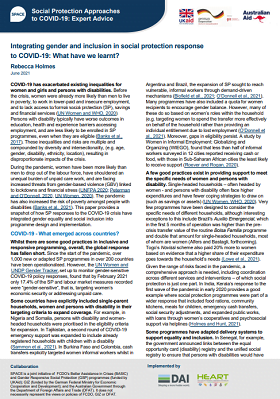
Integrating gender and inclusion in social protection response to COVID-19: What have we learnt?
Policy paper
COVID-19 has exacerbated existing inequalities for women and girls and persons with disabilities. During the pandemic, women have been more likely than men to drop out of the labour force, have shouldered an unequal burden of unpaid care work, and are facing increased threats from gender-based violence...
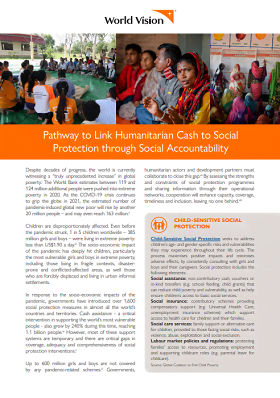
Transfers with Impact – Pathway to Link Humanitarian Cash to Social Protection through Social Accountability
Policy paper
In response to the socio-economic impacts of the pandemic, governments have introduced over 1,600 social protection measures in almost all the world’s countries and territories. Cash assistance – a critical intervention in supporting the world’s most vulnerable people – also grew by 240% during...
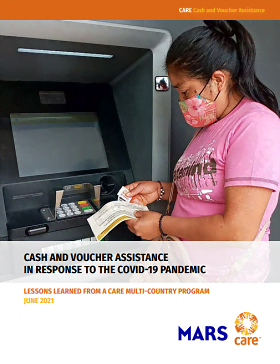
Cash and Voucher Assistance in Response to the COVID-19 Pandemic Lessons Learned from a CARE Multi-Country Program
Report
CARE implemented a multi-country program with the aim of reducing the negative impacts of COVID-19 on vulnerable populations, especially women and girls, using complementary and multimodal approaches, including the provision of cash and voucher assistance (CVA). Given the nature and scale of this program...

CVA for Child Protection Outcomes: Case study from Cambodia
Video
Save the Children Cambodia and seven partner organizations are working to improve households’ ability to care for their children and achieve positive child protection outcomes. With support from USAID Cambodia and European Union in Cambodia, FCF|REACT is providing monthly cash transfers and supporting...

SPACE Drivers of Timely and Large-Scale Cash Responses to COVID-19: what does the data say?
Guidelines and Tools
This note compares the experiences of 53 low- and middle-income countries to identify drivers of timely and large-scale government social assistance responses to COVID-19. The analysis covers cash responses only and focuses on the capacity of the social protection sector and beyond. It compares response...

SPACE Better responding to shocks through social protection: COVID-19 insights on identifying and responding to dynamic poverty
Policy paper
The Coronavirus pandemic has affected substantial proportions of the population raising questions about how social protection systems could be used to respond. One of the key policy questions emerging is how to deal with a sudden, large-scale increase in poverty levels. This paper relies on pre-existing...

SPACE What are future financing options for shock responsive social protection? (Summary Brief)
Policy paper
This paper, and the longer Technical Primer that accompanies it, are designed to inform discussions around financing shock-responsive social protection (SRSP). It starts by clarifying terms and providing a framing to guide approaches to SRSP financing. It then provides a high-level overview of current and...

Social protection and climate change: scaling up ambition
Policy paper
Social protection can be a strategic tool for climate risk management and provides an important answer to the current calls for climate action and for increased resilience as we recover from COVID-19. The Paris Agreement demands rapid action to keep the average temperature from rising above 1.5 degrees,...
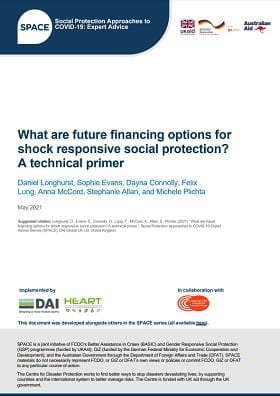
SPACE Gender and Social Protection in the COVID-19 Economic Recovery: Opportunities and Challenges
Policy paper
This paper analyses the potential contribution of social protection to a gender-transformative economic recovery over the medium term, defined as running from the present to the end of 2022. It builds on the existing Social Protection Approaches to COVID-19 Expert (SPACE) advice publication; SPACE Social...
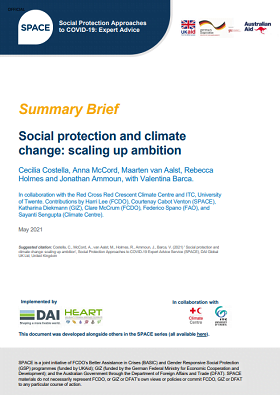
SPACE Social protection and climate change: scaling up ambition (Summary Brief)
Policy paper
Climate change, once perceived as a long-term environmental issue, is now an immediate threat to safety and prosperity, especially for the most vulnerable people that are hit hardest by increasing weather extremes. The impacts cannot be managed just by reducing greenhouse gas emissions or by small tweaks...

What are future financing options for shock responsive social protection? A technical primer
Guidelines and Tools
This paper aims to advance these discussions in a number of ways. As ‘financing for SRSP’ is understood differently by different people, it starts by providing greater clarity on what this term constitutes, and its relation to disaster risk finance. It acknowledges the broad potential remit of...

SPACE Summary Brief: What are future financing options for shock responsive social protection?
Guidelines and Tools
This paper, and the longer Technical Primer that accompanies it, are designed to inform discussions around financing shock-responsive social protection (SRSP). It starts by clarifying terms and providing a framing to guide approaches to SRSP financing. It then provides a high-level overview of current and...

Minding the (financial and digital) gap! – How informal social safety nets leverage digital & cash enablers in COVID-19 pandemic
Presentation
Minding the (financial and digital) gap! – How informal social safety nets leverage digital & cash enablers in COVID-19 pandemic: In every context, strengthening the links between cash transfers, savings groups and digitisation contributes to resilient recovery from COVID-19. Representatives of...
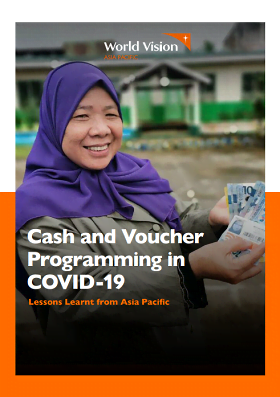
Cash and Voucher Programming in COVID-19, Lessons Learnt from Asia Pacific
Report
COVID-19 has left an indelible adverse impact on all aspects of life not just health but also on livelihood, food security, protection, and many others. After the WHO declared a global pandemic in March 2020, World Vision mindfully scaled up its response to support most vulnerable households through...
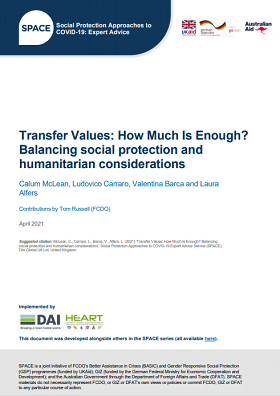
Transfer Values: How Much Is Enough? Balancing social protection and humanitarian considerations
Policy paper
This Operational Guidance paper follows on from two blogs published by SPACE on the subject of transfer values across the social protection and humanitarian nexus (here and here). This note dives even deeper into the topic, highlighting some key elements that could be considered when setting transfer...
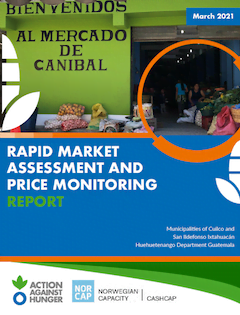
Rapid Market Assessment and Price Monitoring Report – Huehuetenango Department Guatemala
Report
Methodology: This rapid assessment of markets and prices was based on an adapted version of the IFRC’s Rapid Assessment for Markets, elements of the EMMA toolkit’s market system approach and the consortium of NGO’s price monitoring format. The methodology was chosen to give a basic and rapid...

Minutes and recording from the WCAF regional CWG – 20 April 2021
Meeting minutes
Minutes and recording from the WCAF regional CWG – 20 April 2021

Adapting Humanitarian Cash Assistance in Times of COVID-19: Experiences and learning from Jordan
Report
This report examines how cash and voucher actors rapidly adapted to the COVID-19 pandemic in Jordan to reduce transmission risks, ensure delivery of benefits, maintain communication and accountability with refugee populations and meet increasing levels of need. The national response to limit the spread of...

Cash in a COVID-19 crisis: Adapting approaches to assisting Jordan-based refugees
Blog Post
How did cash actors delivering assistance to refugees in Jordan adapt to the COVID-19 crisis? What were the main challenges and did cash actors overcome these? Here to tell us more is André Dürr, an independent consultant specialising in cash transfers who recently carried out a study for the CALP Network.

Adapting Humanitarian Cash Assistance in Times of Covid-19 and Economic Crisis: Comparative Learning from Lebanon and Jordan
Report
This briefing note outlines key lessons that have been learnt in Lebanon and Jordan in adapting humanitarian cash assistance programmes over the past 18 months. The note draws from two briefings: Lebanon’s Pinning Down Moving Targets: adapting humanitarian cash programmes to the multi-pronged crises in...


